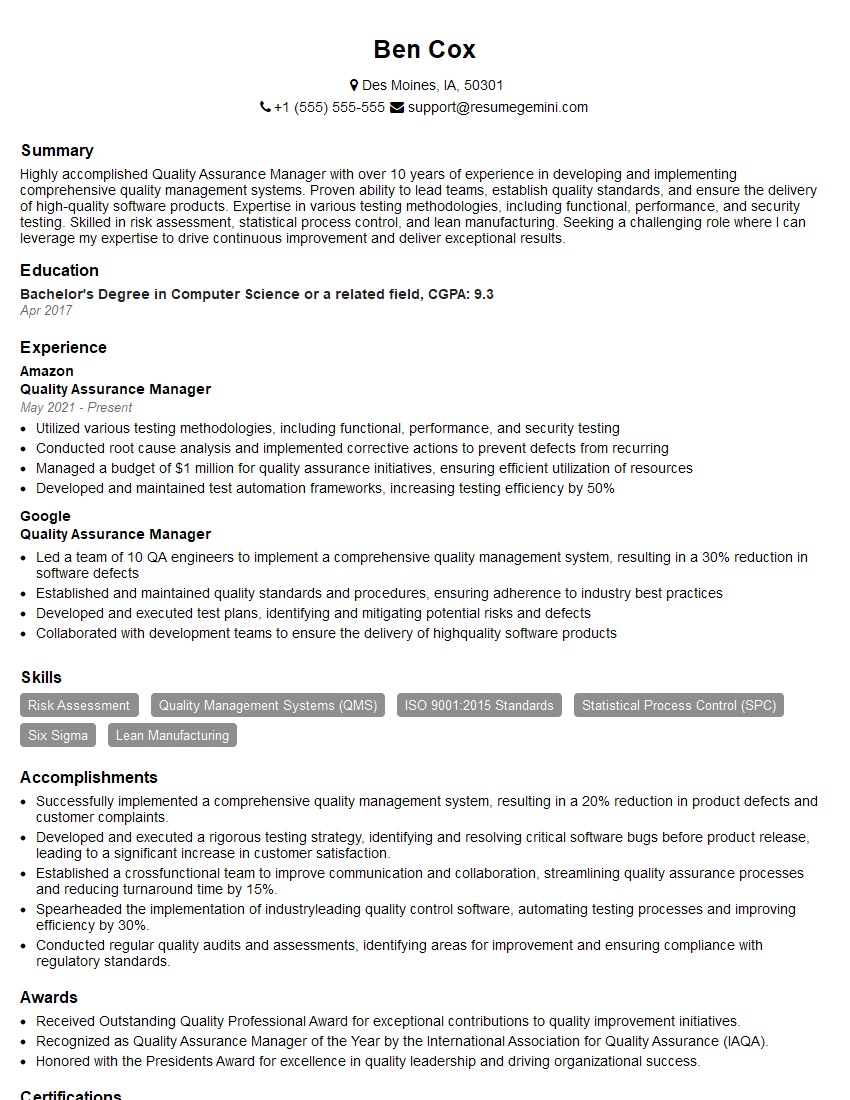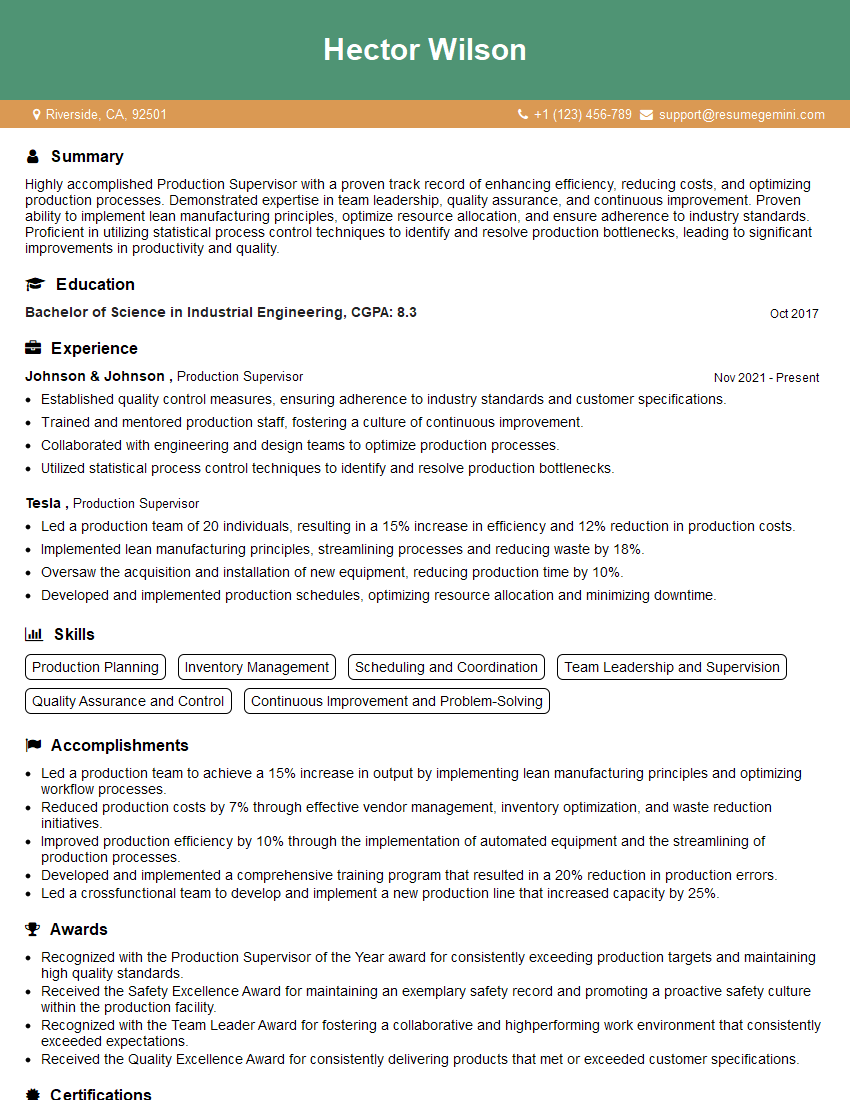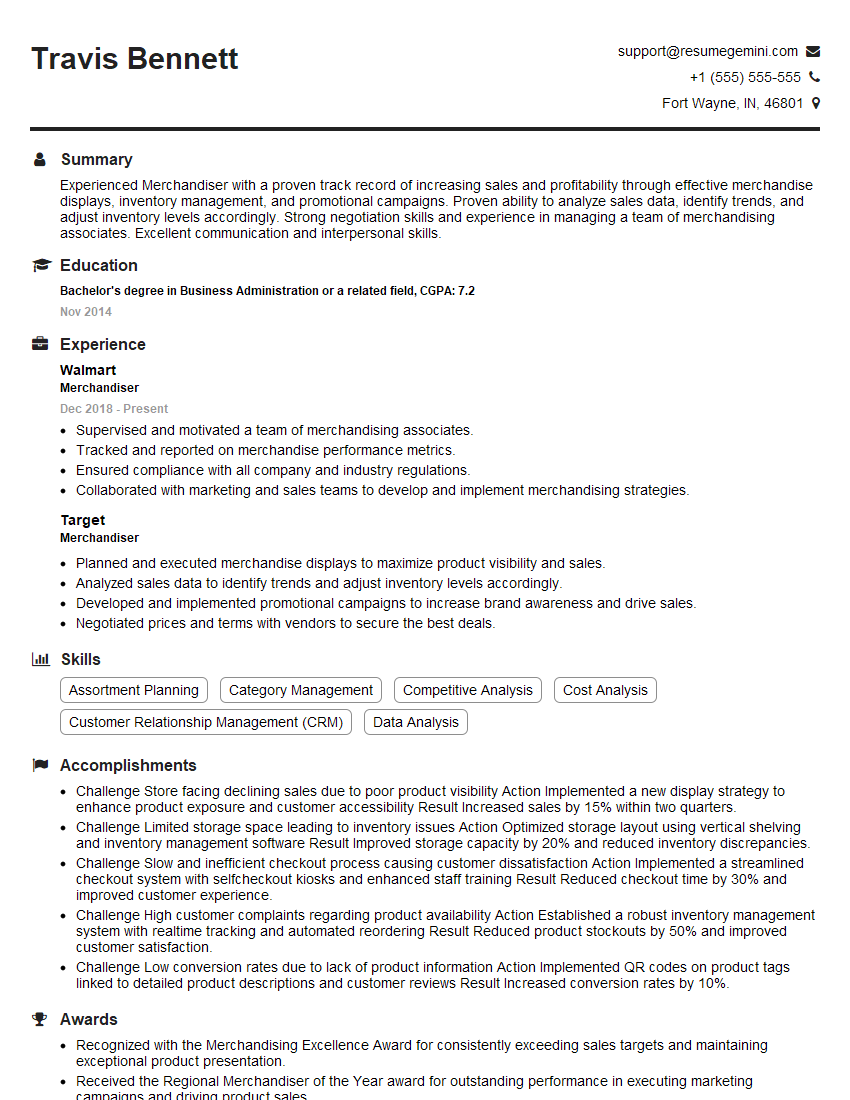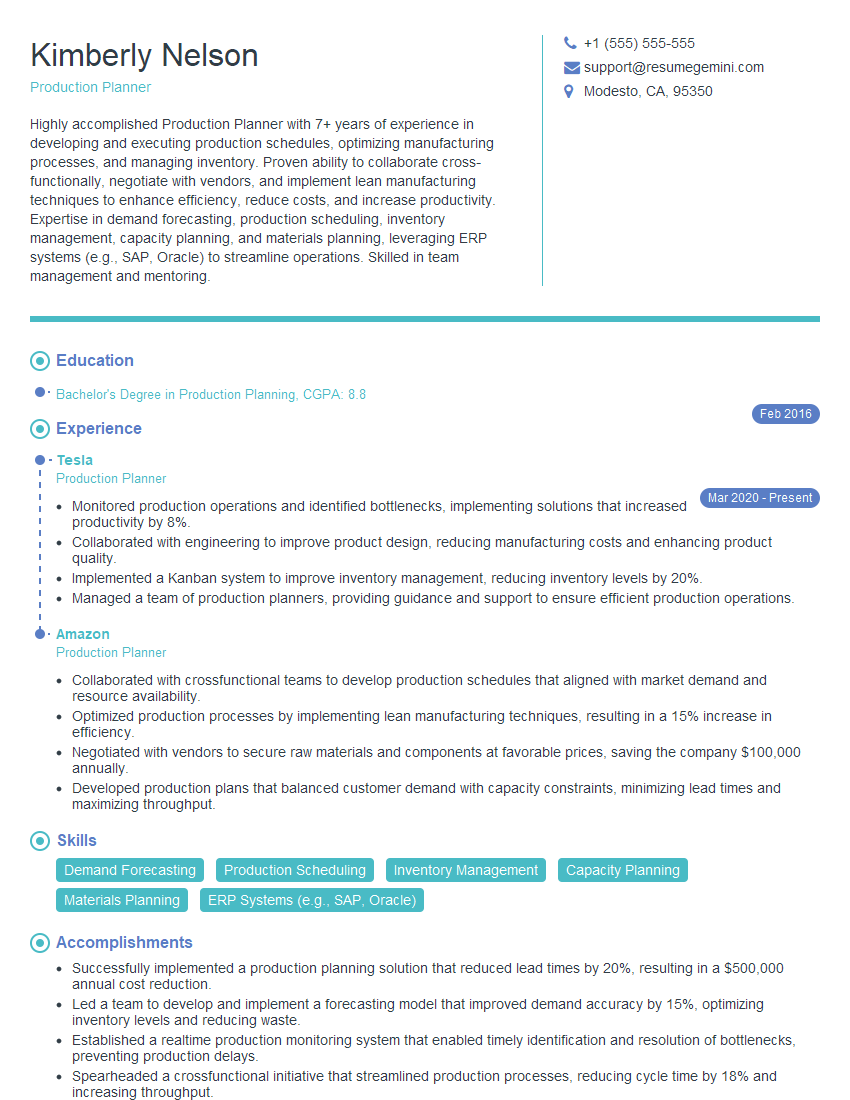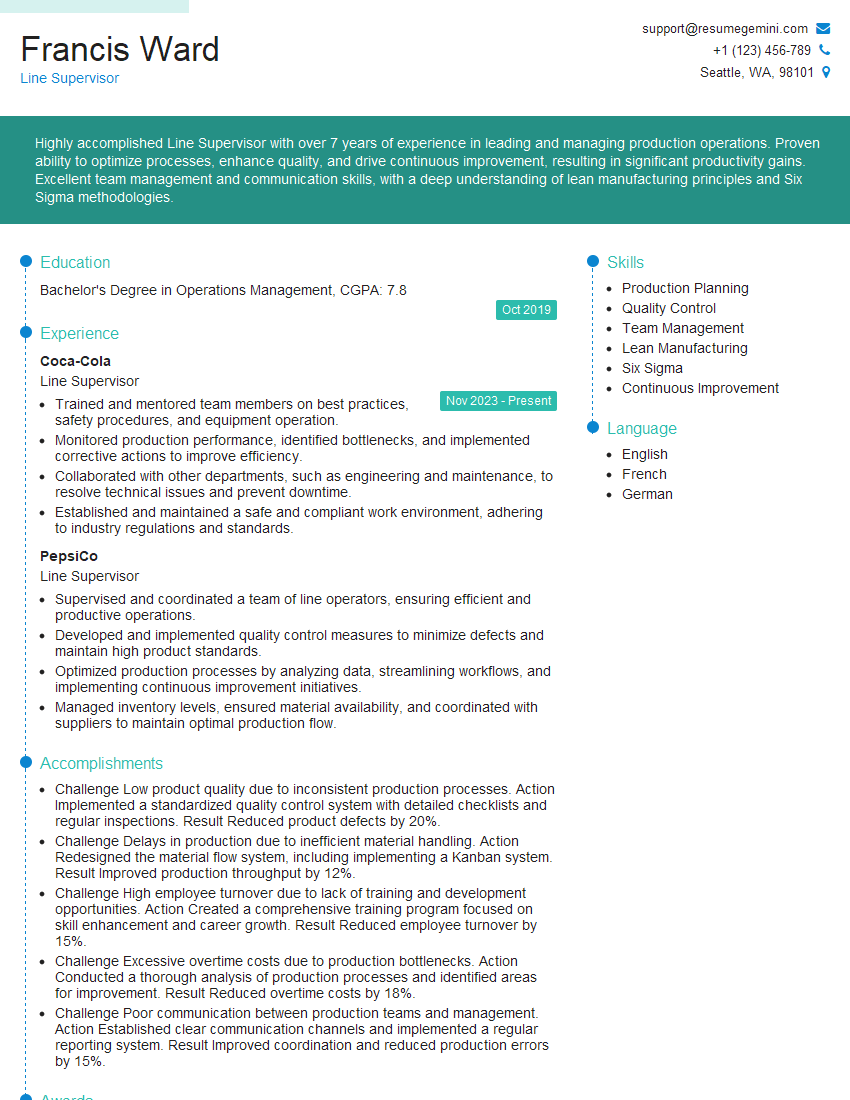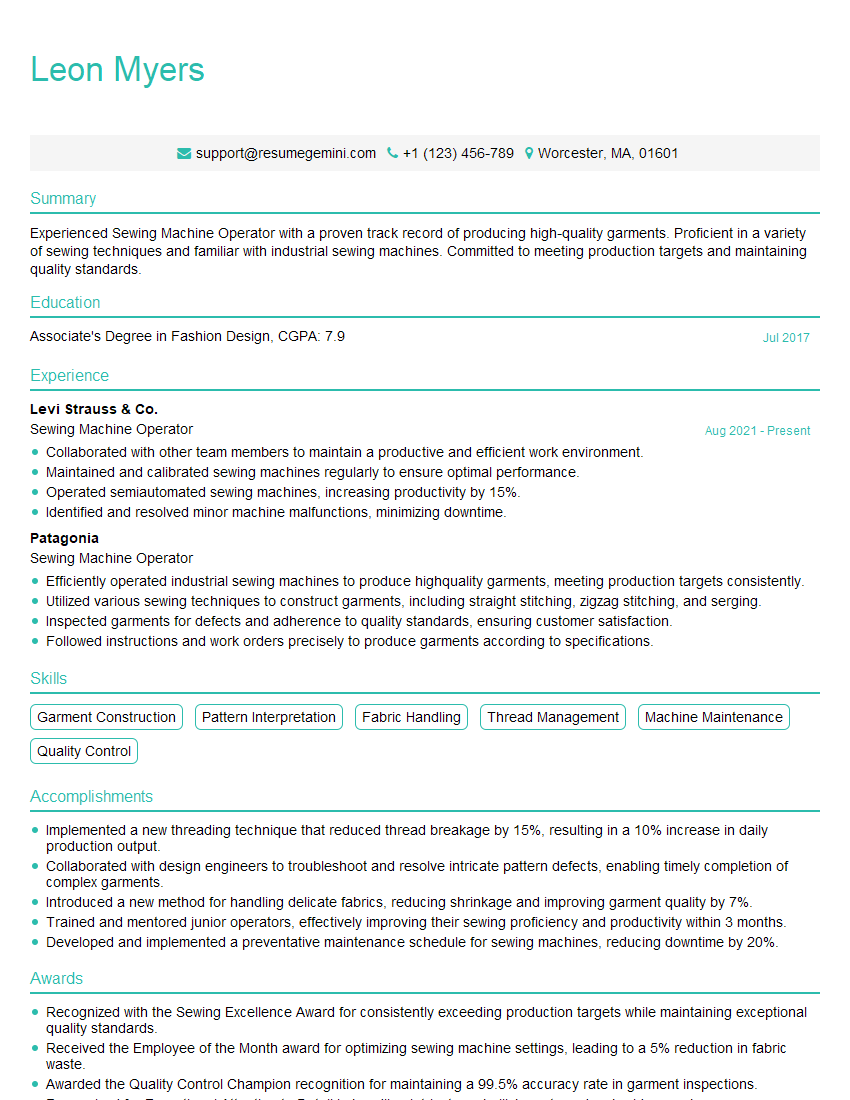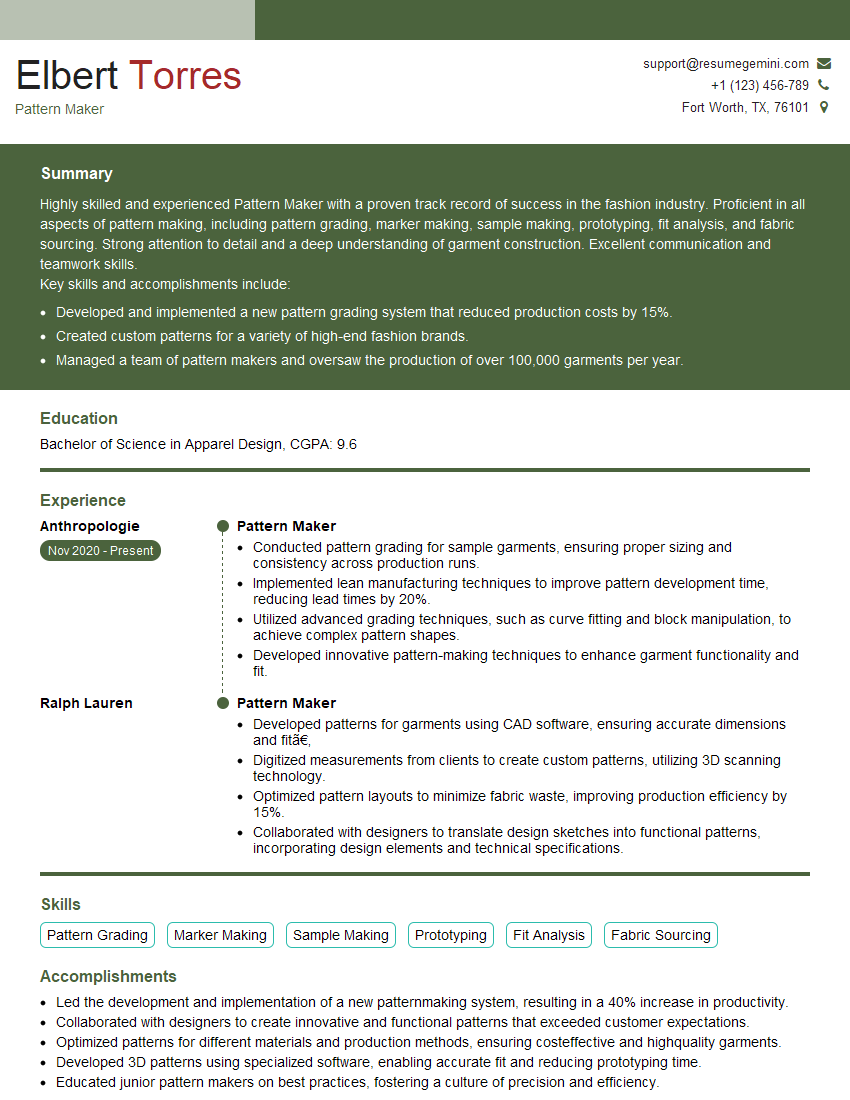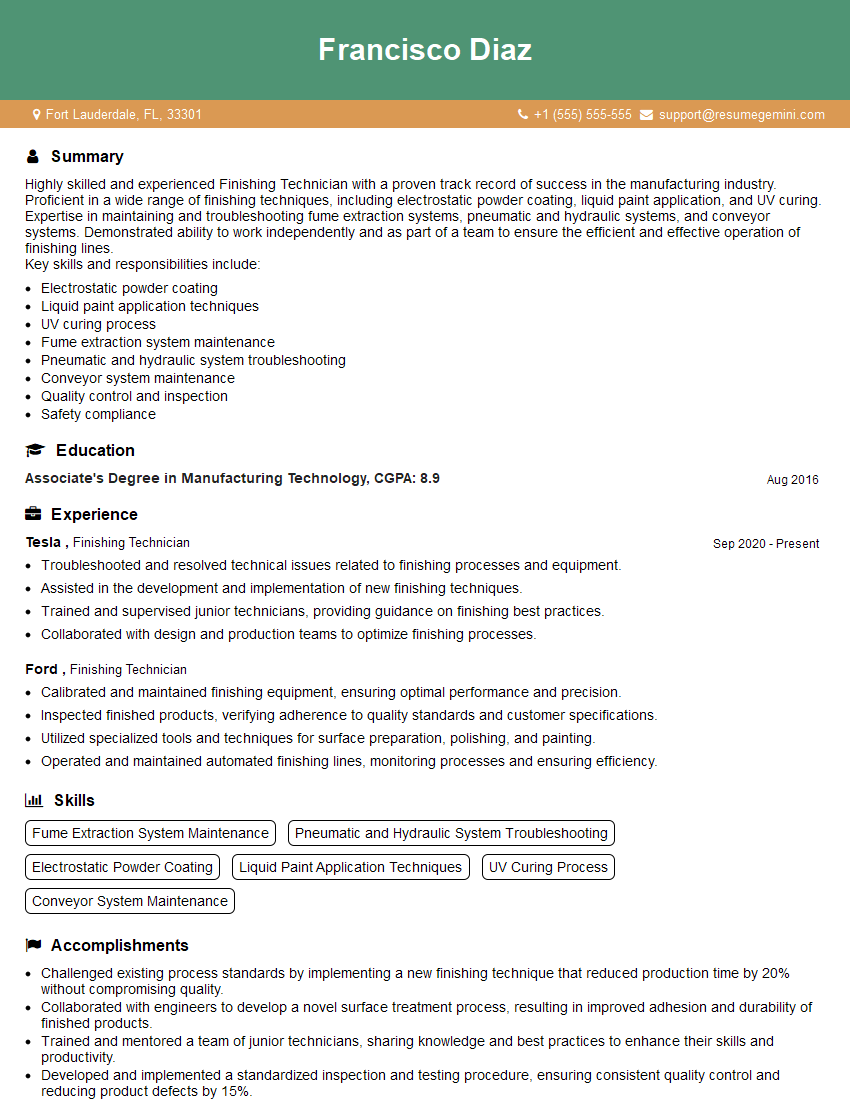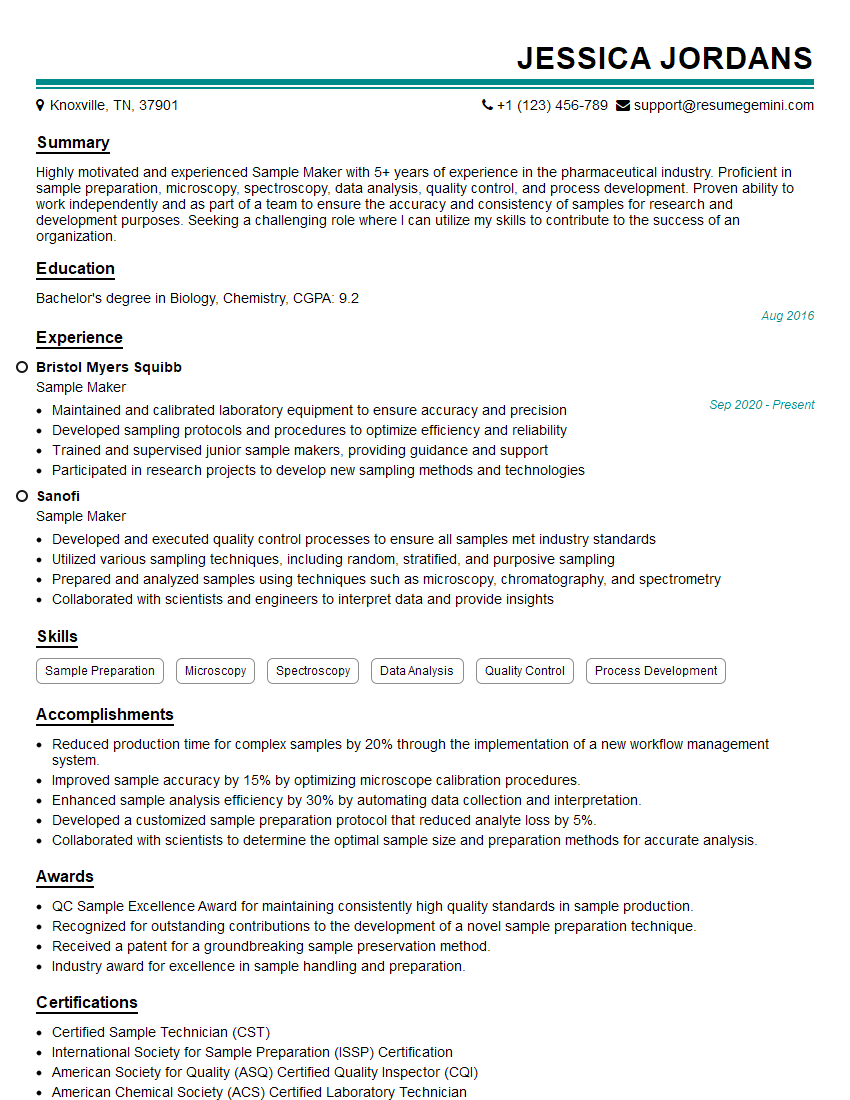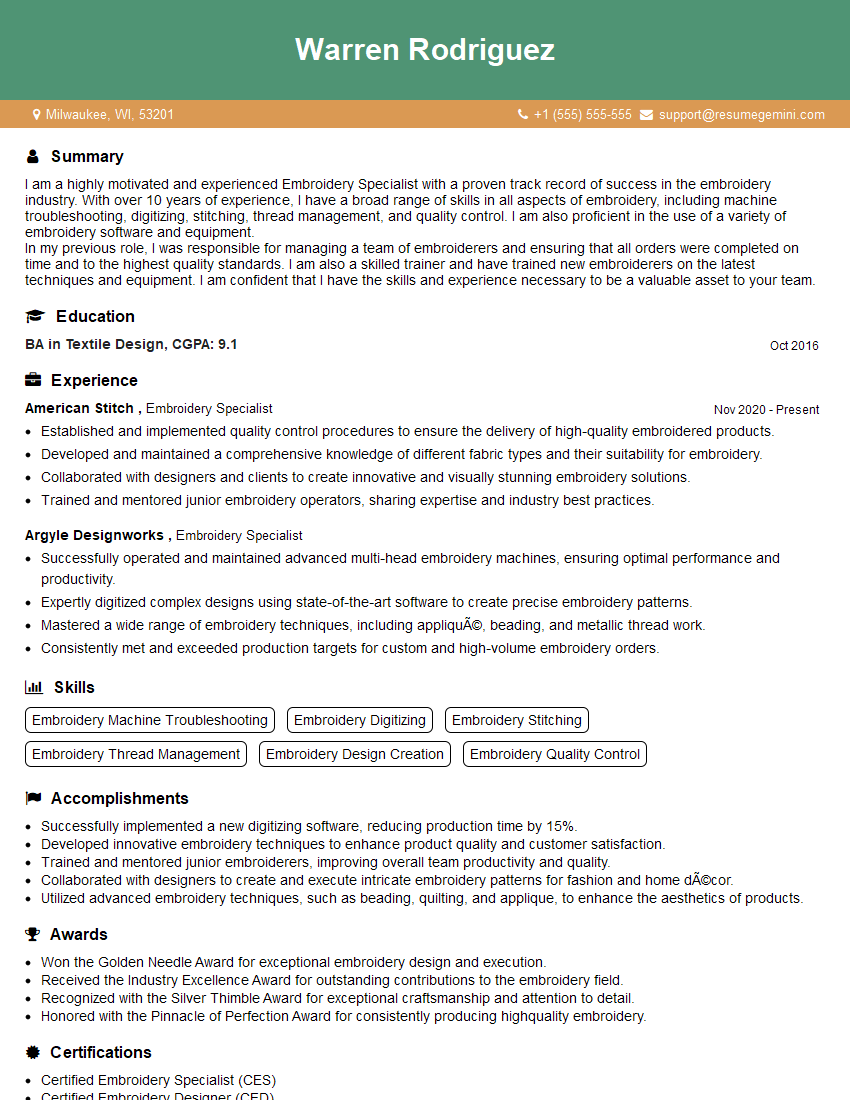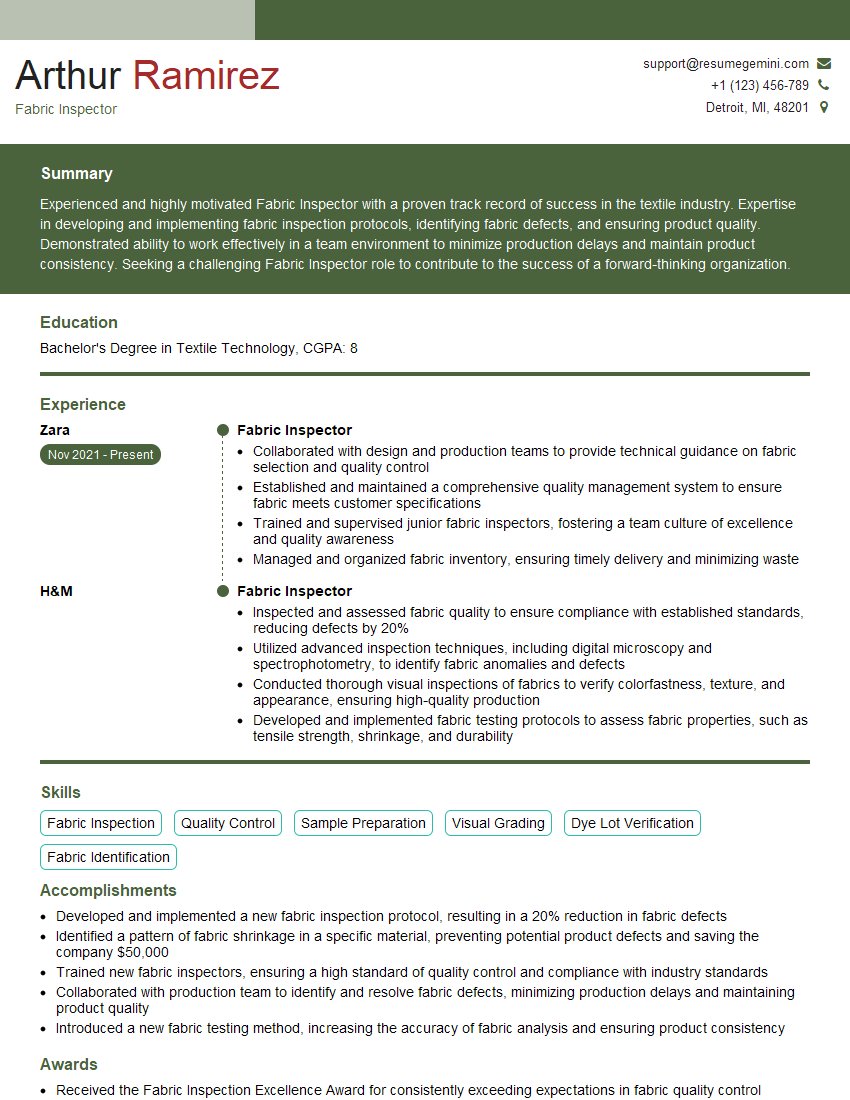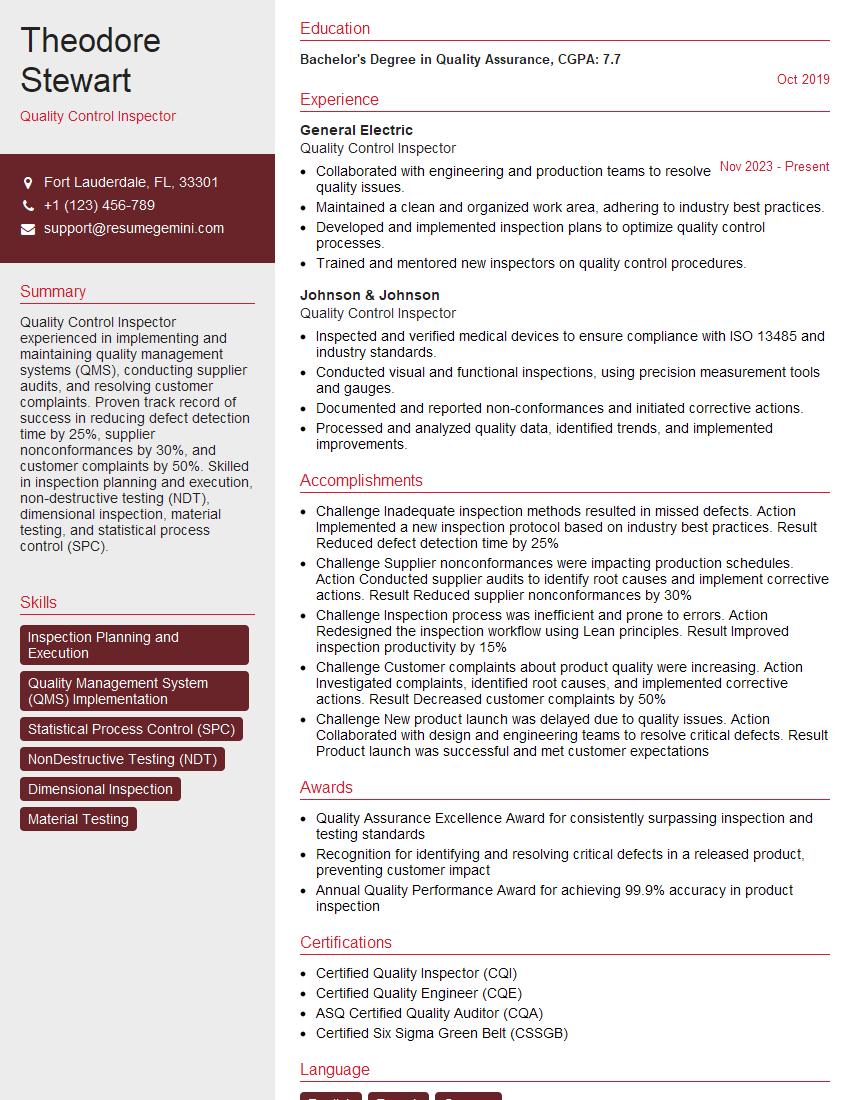Every successful interview starts with knowing what to expect. In this blog, we’ll take you through the top Garment Production interview questions, breaking them down with expert tips to help you deliver impactful answers. Step into your next interview fully prepared and ready to succeed.
Questions Asked in Garment Production Interview
Q 1. What are the key stages in garment production?
Garment production is a multi-stage process, transforming raw materials into finished apparel. Think of it like a relay race, where each stage needs to perform perfectly for the final product to be a winner.
Design & Development: This initial phase involves creating sketches, technical drawings, and developing the pattern. It’s where the garment’s style and functionality are defined. For example, designing a comfortable yet stylish running shirt requires considering fabric drape, ventilation, and moisture-wicking properties.
Sourcing & Fabric Selection: Choosing the right fabric is crucial. Factors such as fiber content, weight, drape, and cost are considered. A high-end silk blouse requires a different sourcing approach than a cotton t-shirt.
Pattern Making & Grading: This stage involves creating the initial pattern piece (master pattern) and then adjusting it for various sizes (grading). This is like baking a cake – you need the right recipe (pattern) and then adjust ingredient quantities (grading) for different sized cakes.
Cutting: The fabric is cut according to the graded patterns. Efficiency and precision are key here to minimize waste and ensure consistent sizing.
Sewing: The cut fabric pieces are sewn together according to the production specs. Different sewing operations (like seams, hems, and closures) are carried out by specialized operators.
Finishing: This involves pressing, washing, and inspecting the garments to ensure quality and consistency. It’s the final polishing to remove any imperfections before packaging.
Packaging & Distribution: The finished garments are folded, tagged, and packaged for shipping to retailers or consumers. This stage is crucial for presenting a professional and consistent brand image.
Q 2. Explain the difference between CMT and full-package garment production.
CMT (Cut, Make, Trim) and Full-Package garment production differ significantly in the level of involvement by the manufacturer.
CMT: In CMT, the manufacturer only handles the cutting, sewing, and trimming of the garments. The client provides the fabric, patterns, and trims (buttons, zippers, etc.). Think of this as outsourcing only the ‘making’ part of the process. It’s cost-effective if you already have your supply chain for materials but need efficient production.
Full-Package: This is a comprehensive service. The manufacturer handles everything from sourcing the fabric and trims to designing, pattern making, cutting, sewing, finishing, and packaging. It’s a turnkey solution—everything is managed by one supplier. This is ideal for businesses who lack in-house expertise or prefer a streamlined supply chain.
The choice depends on the client’s resources, expertise, and the scale of production. A small startup might opt for CMT to initially test the market and scale up to full-package as the business grows.
Q 3. Describe your experience with different sewing machine types.
My experience encompasses a wide range of sewing machines, from basic single-needle machines to advanced computerized models. I’m proficient in using:
Single-needle machines: Essential for various sewing operations, particularly in smaller-scale production or specialized tasks, like attaching buttons or creating intricate seams.
Overlock machines (sergers): These are crucial for creating strong, professional-looking seams and preventing fraying. They’re indispensable for various garment components.
Coverstitch machines: Used for creating decorative and durable seams, often seen on necklines, cuffs, and hems. They give a neat and high-quality finish.
Computerized sewing machines: These machines offer programmable settings, increased precision, and speed, improving efficiency and consistency in high-volume production.
I’m also familiar with specialized machines like button-attaching machines, bar tack machines, and zig-zag machines. My expertise extends to maintaining and troubleshooting these machines to ensure smooth production.
Q 4. How do you ensure quality control throughout the production process?
Quality control is an ongoing process, not just a final step. It’s crucial to catch issues early to prevent costly rework or waste.
In-line inspection: Quality checks are performed at various stages of production, including fabric inspection before cutting, sewing process monitoring, and after each major operation.
Sampling and pre-production checks: Before mass production, samples are produced and meticulously inspected. This allows for early identification and correction of any pattern, construction, or fit issues.
Final inspection: A comprehensive final inspection is conducted to verify adherence to quality standards. This might involve checking for stitching quality, correct sizing, and absence of defects.
Statistical Process Control (SPC): Data-driven methods are used to identify trends and patterns in defects, aiding in proactive quality improvement and root cause analysis.
Using checklists and standardized procedures: Clearly defined checklists and standardized procedures guide every stage of production. This ensures consistency and minimizes human error.
Documenting every step of the quality control process is vital, allowing for traceability and continuous improvement.
Q 5. What are the common fabric defects and how do you identify them?
Fabric defects can significantly impact the quality of the final garment. Identifying them early is crucial.
Weaving defects: These include slubs (thickened areas), holes, broken ends, and mispicks (incorrect interlacing of yarns). They’re often visible during the initial fabric inspection.
Knitting defects: These can be laddering (runs in the fabric), dropped stitches, holes, and variations in stitch density.
Dyeing and Finishing defects: These involve inconsistencies in color, shading, and patterns, also including stains, wrinkles, and uneven finishes. Careful inspection during and after dyeing is crucial.
Fabric flaws: These can range from dirt and foreign fibers to weak areas or variations in the fabric’s weight and texture.
Identifying these defects requires a keen eye and a thorough understanding of textile properties. Using proper lighting and magnification aids can improve detection accuracy.
Q 6. Explain your experience with pattern making and grading.
Pattern making and grading are fundamental skills in garment production. I’m highly experienced in both.
Pattern Making: This involves creating the initial pattern piece based on design sketches, measurements, and technical drawings. I use both draping (directly on a mannequin) and flat pattern techniques, selecting the most appropriate method based on the garment’s style and complexity.
Grading: This is the process of adjusting the master pattern to create different sizes. I utilize both manual and computer-aided grading systems to ensure accurate scaling while maintaining the garment’s proportions and design integrity. Accurate grading is key to ensuring consistent fit across different sizes.
My experience includes creating patterns for a variety of garments, from simple t-shirts to complex structured jackets, demonstrating my adaptability and precision in pattern making and grading.
Q 7. How do you manage production deadlines and meet targets?
Meeting production deadlines requires meticulous planning and effective execution.
Detailed Production Schedule: Creating a comprehensive schedule that breaks down the production process into smaller, manageable tasks with deadlines is vital. This schedule should also account for potential delays.
Efficient Workflow Management: Optimizing workflows, ensuring efficient material flow, and minimizing bottlenecks in each stage of production is essential.
Resource Allocation: Efficient allocation of resources, including personnel, machinery, and materials, is critical to avoid delays.
Communication & Collaboration: Maintaining constant communication between different teams (design, production, quality control) and external suppliers is key for timely problem solving and coordination.
Monitoring & Adjustment: Continuously monitoring progress against the production schedule, identifying any deviations, and adjusting the plan accordingly is necessary. This often involves prioritizing certain tasks to make up for lost time.
My experience in managing large-scale projects with tight deadlines has honed my skills in effective planning, problem-solving, and adaptability. I am confident in my ability to deliver high-quality garments while adhering to strict deadlines.
Q 8. Describe your experience with production planning and scheduling.
Production planning and scheduling in garment manufacturing is the backbone of efficient operations. It involves forecasting demand, allocating resources, and sequencing production activities to meet deadlines and minimize costs. My experience spans across various aspects, from raw material procurement planning to final product delivery. I’ve worked with both simple and complex production schedules, utilizing various techniques including Master Production Scheduling (MPS), Capacity Requirements Planning (CRP), and Material Requirements Planning (MRP).
For instance, in my previous role at [Previous Company Name], we were tasked with producing a large order of customized denim jackets with short lead times. Using MRP, I meticulously tracked the availability of different denim fabrics, threads, zippers, and other components. I then created a detailed production schedule, assigning specific tasks to different production lines based on their capacity and expertise. This involved coordinating with the cutting, sewing, and finishing departments to ensure a smooth workflow and minimize bottlenecks. We successfully delivered the order on time and within budget, exceeding client expectations.
I am also proficient in using software like [Mention Specific Software Used] for production scheduling, enabling detailed tracking and visualization of the production process, leading to improved accuracy and better decision-making.
Q 9. How do you handle production issues and delays?
Handling production issues and delays requires a proactive and systematic approach. My strategy involves identifying the root cause of the problem, implementing corrective actions, and preventing similar issues from recurring. I typically follow these steps:
- Identify the Problem: This involves gathering data from all relevant departments – production, quality control, and procurement – to pinpoint the exact nature and extent of the delay.
- Analyze the Root Cause: This crucial step helps determine whether the delay stems from equipment malfunction, material shortage, quality issues, or labor constraints. Root cause analysis tools like the 5 Whys method are invaluable here.
- Develop Solutions: Once the root cause is identified, I develop and implement corrective actions. This might involve expediting material deliveries, re-allocating resources, addressing equipment failures, or improving training for workers.
- Implement and Monitor: The solutions are implemented and closely monitored. Progress is tracked regularly, and adjustments are made as needed to ensure that the issue is resolved efficiently.
- Prevent Recurrence: Finally, steps are taken to prevent similar delays in the future. This could involve improvements to the production process, better inventory management, or enhanced communication channels.
For example, in one instance, a significant delay occurred due to a faulty sewing machine in the main production line. By promptly identifying the faulty machine, arranging for its repair, and temporarily re-allocating tasks to other lines, I managed to minimize production downtime and meet the deadline with only a minor schedule adjustment.
Q 10. What are your strategies for improving efficiency in garment production?
Improving efficiency in garment production requires a multifaceted approach. My strategies focus on optimizing processes, improving technology, and empowering employees. Some key strategies I employ are:
- Process Optimization: Analyzing each stage of the production process – from pattern making to final inspection – to identify bottlenecks and inefficiencies. This often involves streamlining workflows, eliminating unnecessary steps, and improving layout.
- Technology Integration: Adopting advanced technologies like Computer-Aided Design (CAD) for pattern making, Computer-Aided Manufacturing (CAM) for cutting, and automated sewing machines to improve speed and accuracy.
- Lean Manufacturing Principles: Implementing Lean techniques such as 5S (Sort, Set in Order, Shine, Standardize, Sustain), Kaizen (continuous improvement), and Kanban (visual inventory management) to minimize waste and maximize value.
- Employee Empowerment: Providing training, fostering a culture of continuous improvement, and encouraging employee participation in problem-solving. This boosts morale and improves productivity.
- Quality Control: Implementing robust quality control measures at each stage of production to minimize defects and rework, leading to reduced waste and improved efficiency.
In one project, I implemented a Kanban system to manage the flow of materials through the sewing line, significantly reducing lead times and improving overall efficiency by 15%.
Q 11. Explain your knowledge of different stitching techniques.
My knowledge of stitching techniques is extensive, encompassing various types suitable for diverse fabrics and garment styles. I’m familiar with basic stitches like straight stitch, zigzag stitch, overlock stitch, and blindstitch, as well as more specialized techniques like chainstitch, flatlock stitch, and topstitching.
I understand the importance of selecting the right stitch for the intended application. For instance, a strong overlock stitch is crucial for seams requiring durability, while a delicate blindstitch is ideal for invisible hemming. I’m also proficient in understanding stitch density, tension, and needle selection to achieve optimal results in various fabrics.
Moreover, I can identify stitch defects and understand their causes – for instance, skipped stitches might indicate a faulty needle, while uneven stitching might be due to inconsistent thread tension. This knowledge allows me to troubleshoot stitching issues efficiently and ensure high-quality output.
Q 12. How familiar are you with different types of garment construction?
My experience encompasses a wide range of garment construction methods, including various types of seams, closures, and finishing techniques. I’m familiar with set-in sleeves, raglan sleeves, kimono sleeves, different types of collars (e.g., shirt collar, mandarin collar, shawl collar), various pocket constructions, and different types of closures such as zippers, buttons, snaps, and hook-and-eye closures.
I understand the nuances of constructing garments from different fabrics. For example, the construction techniques for a woven fabric garment (like a shirt) will differ significantly from that of a knit fabric garment (like a t-shirt) due to the inherent properties of the fabrics. I can adapt my approach based on fabric weight, drape, and stretch.
Furthermore, I’m knowledgeable about different types of garment finishing, such as hemming, edge finishing (serging, pinking), and pressing, understanding their crucial role in achieving a high-quality and professional-looking final product. I can assess the construction techniques used in a garment to determine its quality and identify any potential weaknesses.
Q 13. What is your experience with Lean Manufacturing principles in garment production?
Lean Manufacturing principles are crucial for optimizing garment production. My experience includes implementing several Lean techniques to minimize waste, reduce lead times, and improve overall efficiency.
I have successfully implemented 5S methodologies to organize the workspace, reducing search time and improving workflow. Kaizen events have been instrumental in identifying and eliminating bottlenecks within production lines. By focusing on continuous improvement, we were able to improve our overall efficiency and reduce waste.
Furthermore, I’ve utilized Kanban systems for managing workflow, ensuring a smooth flow of materials and reducing inventory build-up. Value stream mapping has been used to analyze and optimize the entire production process, from raw material sourcing to finished goods delivery. The emphasis on eliminating non-value-added activities has resulted in significant cost savings and improved productivity.
Q 14. Describe your experience with using PLM (Product Lifecycle Management) software.
My experience with PLM (Product Lifecycle Management) software is considerable. I have worked with [Mention Specific PLM Software, e.g., Centric PLM, Gerber Technology PLM] to manage the entire product lifecycle, from design and development to production and distribution. This involves using the software for:
- Design Collaboration: Sharing designs, specifications, and technical packages with various teams, streamlining communication and reducing errors.
- Technical Design: Creating and managing technical specifications, including measurements, material requirements, and construction details.
- Production Planning: Planning production schedules, managing material requirements, and tracking production progress.
- Quality Control: Tracking quality control metrics and managing quality issues.
- Document Management: Storing and managing all product-related documents, ensuring easy access and version control.
For example, using PLM software in a previous role allowed us to drastically reduce lead times by streamlining communication between the design team, pattern makers, and production team. The ability to track materials and production progress in real-time enabled proactive problem-solving and minimized production delays. I am proficient in utilizing PLM software to generate reports, analyze data, and make data-driven decisions to optimize the production process.
Q 15. How do you ensure compliance with industry regulations and standards?
Ensuring compliance with industry regulations and standards is paramount in garment production. This involves a multi-faceted approach encompassing ethical sourcing, worker safety, environmental protection, and adherence to quality standards. It’s not just about avoiding penalties; it’s about building trust with consumers and maintaining a positive brand reputation.
- Ethical Sourcing: We meticulously track our supply chain, ensuring compliance with fair labor practices, avoiding child labor, and promoting safe working conditions. This often involves third-party audits and certifications like Fair Trade or BSCI (Business Social Compliance Initiative).
- Worker Safety: Regular safety inspections and training programs are crucial. We provide appropriate personal protective equipment (PPE) and ensure our facilities meet all relevant occupational safety and health regulations. For example, we might implement strict protocols for handling hazardous materials like dyes.
- Environmental Compliance: We minimize our environmental impact by employing environmentally friendly materials, reducing water and energy consumption, and implementing responsible waste management practices. This could involve using eco-friendly dyes and investing in wastewater treatment facilities.
- Quality Standards: We adhere to internationally recognized quality standards such as ISO 9001 to ensure consistent product quality and customer satisfaction. This involves rigorous quality control checks at every stage of the production process, from fabric inspection to final product inspection.
Ultimately, compliance isn’t a one-time task; it’s an ongoing process of continuous improvement and adaptation to evolving regulations and best practices. We regularly review our procedures and invest in training to stay ahead of the curve.
Career Expert Tips:
- Ace those interviews! Prepare effectively by reviewing the Top 50 Most Common Interview Questions on ResumeGemini.
- Navigate your job search with confidence! Explore a wide range of Career Tips on ResumeGemini. Learn about common challenges and recommendations to overcome them.
- Craft the perfect resume! Master the Art of Resume Writing with ResumeGemini’s guide. Showcase your unique qualifications and achievements effectively.
- Don’t miss out on holiday savings! Build your dream resume with ResumeGemini’s ATS optimized templates.
Q 16. What are your methods for cost reduction in garment production?
Cost reduction in garment production requires a strategic approach focusing on efficiency, material selection, and waste minimization. It’s about optimizing processes without compromising quality or ethical standards.
- Efficient Production Planning: We use advanced planning systems to optimize production schedules, minimize downtime, and maximize machine utilization. This involves carefully analyzing production capacity, lead times, and demand forecasts to avoid bottlenecks and excess inventory.
- Smart Material Sourcing: Negotiating favorable prices with suppliers and exploring alternative, cost-effective materials without compromising quality is crucial. For example, switching to a slightly less expensive, but equally durable, fabric can significantly reduce material costs.
- Waste Reduction: Implementing lean manufacturing principles helps minimize fabric waste during cutting and sewing. Techniques such as nesting patterns efficiently and using fabric scraps creatively can significantly reduce material costs.
- Automation and Technology: Investing in automated machinery can enhance productivity and reduce labor costs in the long run. This could include automated cutting machines or advanced sewing equipment.
- Negotiating with Suppliers: Building strong relationships with reliable and efficient suppliers enables us to leverage economies of scale and negotiate better prices.
For example, in one project, we implemented a new cutting optimization software which reduced fabric waste by 15%, leading to substantial cost savings without impacting the quality of the finished garments.
Q 17. How do you manage a team of garment production workers?
Managing a team of garment production workers requires a blend of leadership, communication, and technical expertise. It’s about fostering a positive and productive work environment where everyone feels valued and empowered.
- Clear Communication: Open and transparent communication is key. Regular team meetings, clear instructions, and feedback sessions help ensure everyone understands their roles and responsibilities.
- Training and Development: Investing in training and development programs improves worker skills, boosts morale, and increases productivity. This could involve providing training on new technologies or advanced sewing techniques.
- Motivation and Empowerment: Recognizing and rewarding good work boosts morale and productivity. Creating a positive work environment where workers feel valued and respected is crucial for team success. This might involve implementing incentive programs or recognizing individual achievements.
- Fair Labor Practices: Adhering to fair labor practices, including providing competitive wages and benefits, is vital for attracting and retaining skilled workers.
- Conflict Resolution: Addressing conflicts promptly and fairly is essential for maintaining a harmonious work environment. This might involve implementing clear conflict resolution procedures and providing mediation services.
I believe in leading by example and fostering a collaborative spirit. In my previous role, I successfully implemented a training program that reduced errors by 20% and increased overall team productivity by 10%.
Q 18. What is your experience with capacity planning in garment production?
Capacity planning in garment production is crucial for meeting deadlines, optimizing resource allocation, and avoiding production bottlenecks. It involves accurately forecasting demand, assessing production capacity, and making adjustments as needed.
- Demand Forecasting: Accurate demand forecasting is the foundation of effective capacity planning. This involves analyzing historical sales data, market trends, and customer orders to predict future demand. We utilize sophisticated forecasting techniques to get the most accurate predictions.
- Capacity Assessment: We regularly assess our production capacity by analyzing machine utilization rates, labor availability, and production lead times. This involves identifying potential bottlenecks and areas for improvement.
- Resource Allocation: Based on demand forecasts and capacity assessments, we optimize the allocation of resources, including machinery, labor, and materials. This might involve adjusting production schedules or investing in additional equipment.
- Contingency Planning: It’s important to develop contingency plans to handle unexpected events, such as equipment malfunctions or unexpected surges in demand. This might involve having backup equipment or flexible workforce arrangements.
For instance, during peak seasons, we often utilize temporary staffing to increase our production capacity and meet customer demand without compromising quality or deadlines. We also use software to optimize our cutting and sewing schedules to meet changing demand.
Q 19. Describe your experience with different types of garment finishing techniques.
Garment finishing techniques significantly impact the final look, feel, and durability of a garment. My experience encompasses a wide range of techniques, from basic to specialized processes.
- Washing and Finishing: This includes various washing processes (e.g., enzyme wash, stone wash, acid wash) to achieve specific effects like softening, fading, or distressing. Each wash process requires careful control of parameters like temperature and chemicals to achieve the desired result.
- Dyeing: I’m experienced in different dyeing techniques, including piece dyeing, garment dyeing, and yarn dyeing. The choice of dyeing technique significantly impacts the final look and feel of the garment and its colorfastness.
- Printing: I’m familiar with various printing techniques, such as screen printing, digital printing, and heat transfer printing, each offering different levels of detail, flexibility, and cost-effectiveness.
- Embroidery and Appliqué: These techniques add decorative elements to garments, enhancing their aesthetic appeal. We use sophisticated embroidery machines and employ skilled embroiderers for high-quality results.
- Special Finishes: I’m also familiar with specialized finishes like water-repellent treatments, wrinkle-resistant finishes, and anti-microbial treatments. The selection of these finishes is often driven by the garment’s intended use and target market.
One particular project involved developing a new garment dyeing process that resulted in a more even color distribution and reduced fabric shrinkage, leading to improved quality and reduced waste.
Q 20. How familiar are you with different types of fabrics and their properties?
A deep understanding of fabrics and their properties is essential in garment production. This knowledge allows for informed material selection, optimal construction techniques, and accurate cost estimations.
- Fiber Content: I’m proficient in identifying and understanding different fiber types (e.g., cotton, polyester, silk, wool, linen) and their respective properties such as strength, drape, absorbency, and wrinkle resistance. This impacts garment construction and end-use suitability.
- Fabric Construction: I understand various fabric constructions, including knits, wovens, and non-wovens, and their impact on drape, durability, and cost. For example, knowing the difference between a plain weave and a twill weave allows for choosing the appropriate fabric for a specific garment design.
- Fabric Finishes: I’m familiar with various fabric finishes (e.g., mercerized cotton, brushed fleece) and their impact on the fabric’s hand feel, appearance, and performance. This helps to select appropriate fabrics to meet design and performance requirements.
- Fabric Weight and Drape: Understanding fabric weight and drape is crucial for selecting the right fabric for a specific garment style and design. A heavier fabric may be suitable for a coat, while a lighter fabric is better suited for a summer dress.
My experience allows me to select fabrics that not only meet aesthetic requirements but also ensure the garment’s durability, comfort, and ease of care. For example, I was able to specify a performance fabric for an athletic wear line that ensured both comfort and moisture-wicking properties.
Q 21. What is your experience with sourcing and selecting fabrics?
Sourcing and selecting fabrics is a critical aspect of garment production, impacting both cost and quality. It involves careful consideration of several factors.
- Supplier Evaluation: We thoroughly evaluate potential fabric suppliers based on their quality standards, production capacity, ethical practices, and pricing. This includes conducting site visits and reviewing certifications.
- Fabric Testing: Before committing to a fabric, we conduct rigorous testing to ensure it meets our quality standards in terms of strength, colorfastness, shrinkage, and other relevant properties. This ensures that the fabric is suitable for the intended garment and meets industry standards.
- Negotiation and Pricing: We negotiate favorable prices with suppliers while ensuring a balance between cost and quality. This involves considering factors like order volume, lead times, and payment terms.
- Lead Time Management: We carefully manage lead times to ensure timely fabric delivery and avoid production delays. This requires effective communication and collaboration with suppliers.
- Sustainability and Ethics: We prioritize sourcing fabrics from suppliers that adhere to ethical and sustainable practices, minimizing our environmental impact and supporting fair labor standards.
In a recent project, we successfully sourced a sustainable organic cotton fabric from a certified supplier, reducing our environmental footprint while maintaining a high level of quality. This involved extensive research and negotiations to ensure both quality and ethical sourcing.
Q 22. Explain your understanding of costing and pricing in garment production.
Costing and pricing in garment production are crucial for profitability. Costing involves calculating all expenses associated with producing a garment, from raw materials and labor to overhead and shipping. Pricing, on the other hand, involves determining the selling price to ensure a profit margin while remaining competitive. It’s a delicate balance.
Costing Components: A comprehensive costing breakdown includes:
- Raw Materials: Fabric, trims (zippers, buttons, etc.), interlinings.
- Manufacturing: Cutting, sewing, embroidery, finishing, quality control.
- Labor: Wages for all production personnel.
- Overhead: Rent, utilities, equipment maintenance, administrative costs.
- Shipping & Handling: Transportation costs to the customer.
- Profit Margin: The desired percentage of profit added to the total cost.
Pricing Strategies: Pricing is often based on cost-plus pricing (adding a percentage markup to the total cost) or value-based pricing (setting a price based on perceived value to the customer). Negotiation also plays a significant role, especially with large orders.
Example: Let’s say the total cost of producing a shirt is $10. A 20% markup would result in a selling price of $12. However, market analysis might indicate that a $15 price point is achievable, offering a higher profit margin.
Q 23. How do you handle customer complaints and feedback related to garment quality?
Handling customer complaints and feedback related to garment quality is paramount for maintaining reputation and customer loyalty. My approach involves a systematic process:
- Acknowledge and empathize: Begin by acknowledging the customer’s frustration and showing genuine empathy. A simple, ‘I understand your concern’ goes a long way.
- Gather information: Request details about the issue, including photos or videos if possible. This helps pinpoint the problem’s root cause.
- Investigate the issue: Internally, I’d investigate the complaint, examining the manufacturing process, the materials used, and any potential quality control failures.
- Determine the solution: Depending on the severity and nature of the problem, solutions might include offering a replacement garment, a refund, or a discount on future purchases.
- Communicate promptly: Update the customer regularly on the progress of the investigation and resolution.
- Learn from the experience: Analyze the root cause of the complaint to implement preventative measures and improve quality control procedures in the future.
Example: If a customer complains about stitching inconsistencies, I would review the sewing machine settings, operator training records, and the inspection process to identify and rectify the underlying problem. This might involve adjusting machine tension, providing additional training, or enhancing the inspection checklist.
Q 24. What is your experience with inventory management in garment production?
Effective inventory management is vital for efficient garment production. It minimizes waste, reduces storage costs, and prevents stockouts. My experience includes using various methods:
- Just-in-Time (JIT) Inventory: This system minimizes inventory by ordering materials only when needed. It’s highly effective for reducing storage costs but requires precise demand forecasting.
- First-In, First-Out (FIFO): This method prioritizes using the oldest inventory first, minimizing the risk of material spoilage or obsolescence.
- ABC Analysis: This categorizes inventory items based on their value and usage. High-value items (A) receive more attention and control than low-value items (C).
- Inventory Tracking Software: Using software to manage inventory provides real-time visibility into stock levels, enabling better planning and purchasing decisions. This software typically includes features for tracking materials, work in progress, and finished goods.
Example: In a previous role, we implemented an ABC analysis of our fabric inventory. This allowed us to focus our efforts on managing the high-value fabrics (A category) more closely, minimizing losses due to obsolescence and ensuring sufficient stock for high-demand items.
Q 25. Describe your experience with working with different types of orders (small, large, urgent).
My experience spans working with diverse order types, each demanding a unique approach:
- Small Orders: These often require a more personalized approach, focusing on close collaboration with the customer and efficient use of resources. It’s important to balance the cost of production with the smaller profit margin.
- Large Orders: These demand robust planning and efficient resource allocation. Effective communication and coordination are crucial across different departments (design, production, quality control, shipping).
- Urgent Orders: These require flexibility and prioritization. Overtime, expedited shipping, and streamlining the production process are common strategies for meeting tight deadlines. Prioritization and clear communication are paramount.
Example: For a recent urgent order, we prioritized the production line by focusing exclusively on that order until it was completed. We also utilized overtime pay to meet the deadline. This increased our labor costs, but it ensured customer satisfaction and maintained our reputation for reliability.
Q 26. How do you ensure the safety and well-being of your production team?
Ensuring the safety and well-being of my production team is a top priority. My approach is multifaceted:
- Workplace Safety Training: Providing regular training on safe operating procedures for machinery, handling materials, and emergency procedures.
- Safe Work Environment: Maintaining a clean, well-lit, and organized workspace, free from hazards. This includes proper ventilation and ergonomic workstations.
- Personal Protective Equipment (PPE): Ensuring that all employees have and use the appropriate PPE, such as safety glasses, gloves, and masks, as needed.
- Regular Safety Inspections: Conducting regular inspections to identify and address potential hazards promptly.
- Emergency Response Plan: Implementing and regularly practicing an emergency response plan to handle accidents or emergencies effectively.
- Open Communication: Fostering an environment where employees feel comfortable reporting safety concerns without fear of reprisal.
Example: We implemented a ‘stop work’ authority, empowering any employee to halt production if they identify a safety hazard. This fosters a culture of responsibility and emphasizes the importance of safety over production speed.
Q 27. What is your experience with implementing new technologies in garment production?
Implementing new technologies is essential for staying competitive in the garment production industry. My experience includes:
- Computer-Aided Design (CAD): Using CAD software for pattern making and design, improving efficiency and precision.
- Computer-Aided Manufacturing (CAM): Utilizing CAM systems for automated cutting and sewing processes, increasing productivity and reducing labor costs.
- 3D Printing: Exploring the use of 3D printing for prototyping and creating custom designs.
- Automated Quality Control Systems: Implementing automated systems for inspecting garments, improving accuracy and consistency.
- Enterprise Resource Planning (ERP) Systems: Utilizing ERP software to integrate various aspects of production, from design to shipping, enabling better data management and decision-making.
Example: In a previous role, we implemented a CAD system that reduced pattern-making time by 40%, streamlining the design process and enabling faster turnaround times for customer orders.
Q 28. How do you stay updated on the latest trends and technologies in garment production?
Staying updated on the latest trends and technologies is critical in this dynamic industry. My strategies include:
- Industry Publications and Journals: Regularly reading trade publications and journals to keep abreast of new developments and innovations.
- Industry Conferences and Trade Shows: Attending conferences and trade shows to network with industry professionals and learn about the latest technologies.
- Online Resources and Webinars: Utilizing online resources and webinars to access information and insights from industry experts.
- Professional Organizations: Participating in professional organizations to stay connected with the industry and benefit from shared knowledge.
- Competitor Analysis: Monitoring the activities of competitors to understand their innovations and strategies.
Example: I regularly attend the Apparel Sourcing Show to network with suppliers and explore new fabrics and technologies. This keeps me informed about emerging trends in materials and production techniques.
Key Topics to Learn for Garment Production Interview
- Pattern Making & Grading: Understanding the process from initial design to creating production patterns, including grading for different sizes. Practical application: Explaining your experience with different pattern-making software and techniques, and troubleshooting sizing inconsistencies.
- Fabric Selection & Sourcing: Knowledge of different fabric types, their properties, and suitability for various garments. Practical application: Discussing your experience selecting fabrics based on cost, quality, and end-use, and identifying potential fabric sourcing challenges and solutions.
- Production Planning & Management: Understanding production timelines, capacity planning, and efficient workflow management. Practical application: Describing your experience in optimizing production processes, managing resources, and meeting deadlines.
- Quality Control & Assurance: Implementing quality checks throughout the production process to ensure consistent standards. Practical application: Explaining your experience with quality control methodologies, identifying and resolving defects, and ensuring adherence to quality standards.
- Sewing Technology & Machinery: Familiarity with different sewing machines, their capabilities, and maintenance. Practical application: Describing your experience operating various sewing machines and troubleshooting common mechanical issues.
- Costing & Budgeting: Understanding the cost breakdown of garment production and developing accurate budgets. Practical application: Explaining your experience in calculating garment costs, including materials, labor, and overhead, and managing production within budgetary constraints.
- Sustainability & Ethical Practices: Understanding and implementing sustainable and ethical practices in garment production. Practical application: Discussing your knowledge of sustainable materials, ethical sourcing, and environmentally friendly manufacturing processes.
Next Steps
Mastering garment production opens doors to exciting career advancements, from supervisory roles to leading innovative projects. To significantly enhance your job prospects, create an ATS-friendly resume that highlights your skills and experience effectively. ResumeGemini is a trusted resource to help you build a professional and impactful resume that catches the eye of recruiters. Examples of resumes tailored specifically for Garment Production roles are available to guide you.
Explore more articles
Users Rating of Our Blogs
Share Your Experience
We value your feedback! Please rate our content and share your thoughts (optional).
What Readers Say About Our Blog
Hi, I have something for you and recorded a quick Loom video to show the kind of value I can bring to you.
Even if we don’t work together, I’m confident you’ll take away something valuable and learn a few new ideas.
Here’s the link: https://bit.ly/loom-video-daniel
Would love your thoughts after watching!
– Daniel
This was kind of a unique content I found around the specialized skills. Very helpful questions and good detailed answers.
Very Helpful blog, thank you Interviewgemini team.
